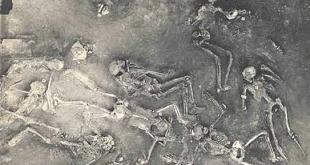
Niyoga, a literal meaning of the term would be ‘delegation’. Here this has to do with the idea of delegating a husband’s duty of providing his married wife with a child, to some other man; ideally a brother or a close relative. Circumstances such as the husband being impotent, or that he has died without any successful attempt at procreation, or that he has renounced the world and has chosen to be an ascetic, are frequently quoted.
The entire idea of such delegation stems from the importance given to the furthering of a family lineage in traditional and modern societies even. If a married couple is not able to bear children, a male child more specifically, questions like who will be the carrier of their family name after their death, or who will be the inheritor of whatever wealth and property they have accumulated, warrant use of social constructs such as this for course-correction to the best degree possible; i.e. get a baby boy, an heir apparent.
Niyoga, the ritual finds mention in various scriptures of Hinduism as well as other world religions. It was practiced as a widely accepted measure to be undertaken for the greater good of society; under set, rigidly defined guidelines. The Niyoga, as a procedure has been evolving along with the changing opinions of times mainly to accommodate opposing opinions of the times.
The concept of Niyoga has undergone subtle changes over time to accommodate those dominant opinions, but some implicit clauses such as these remain:
- The woman would agree to this only for the sake of rightfully having a child and not for pleasure.
- The appointed man would do this for Dharma, considering it as his duty to help the woman bear a child and not for pleasure.
- The child, thus born would be considered the child of the husband-wife and not that of the appointed man.
- The appointed man would not seek any paternal relationship or attachment to this child in the future.
- To avoid misuse, a man was allowed a maximum of three times in his lifetime to be appointed in such a way.
- The act will be seen as that of Dharma and while doing so, the man and the wife will have only Dharma in their mind and not passion nor lust. The man will do it as a help to the woman in the name of God, whereas the woman will accept it only to bear the child for herself and her husband.
- There would be no foreplay, oral or any other type of sexual activity except the intercourse.
- There would be a semi-transparent curtain covering the upper part of the woman, only allowing view and access to her lower part for the man performing niyoga.
- The bodies are to be covered with ghee (a type of clear butter used in South Asian cooking), so that lust may not take root in the minds of the participants but the actual act may take place for conception only.
In the Mahabharata, when Pandu was cursed to die if he got intimate with any woman, his wives Kunti and Madri had to resort to niyoga with the gods to mother their five sons – the Pandavas. Though this wasn’t as prescribed by Niyoga, it was moulded a bit to include the gods (devas) to suit the requirements of the mothers of the pandavas.
In the Ramayana, Kalmashapada is the ancestor of Rama. His queen Madayanti had resorted to niyoga with sage Vashista to bear a child named Ashmaka. The Ramayana also adds that this act of “giving” his wife to a Brahmin helps Kalmashapada, the “father” attain heaven.
In Sanskrit, pati, the term which in hindi means husband, also means king. In some records, instead of the brother of the husband or a close relative taking up the responsibility of granting the wife with a child, the king would be invited.
There have been instances of similar arrangements in other world cultures throughout history. One of them is Levirate Marriage which finds mention in Judaism, Islam and Christianity among others.
Levirate Marriage is a type of marriage in which the brother of a deceased man is obliged to marry his brother’s widow, and the widow is obliged to marry her deceased husband’s brother. The key word here is obligation.
Also, it is different from the concept of Niyoga in one crucial detail, which is the importance given to a union through marriage prior to the conception of a child within any such arrangement. This helped define boundaries and silence oppositions to such methods of producing an heir to the family.

In the novel, Mathurobhagan (One Part Woman – published in English in 2014), Perumal Murugan brings to the fore the ritual that was practiced in Tiruchengonde, a small village in central Tamil Nadu. The story is set in the 1940s around a childless couple, kali and ponna, who are desperately looking for ways to conceive a child. The plot builds up to a ritual in the Maathorubaagan temple where the protagonist joins other childless women engaging in free sex in an attempt to get impregnated. A child born out of such a relation was treated as gift of God. This portrayal of women, this sexual permissiveness depicted, offended ardent religious fanatics and protests ensued; all culminating in the suicide of the writer inside Perumal Murugan. He is alright but freedom of speech had received a fatal blow in that moment for this country (India).
On a much lighter note, as an ardent environmentalist, I find advertisements for fully furnished housings and offices to be the most offensive things I can imagine. Why am I not burning effigies and catalogues of furniture companies? Well, mostly because, it wouldn’t be right and I know that.
In the modern age, Niyoga still survives. It only has put on new names. Surrogates and artificial insemination are a go-to as even today the root cause for the practice remains. The importance attached to a child and family lineage still hold. However, the important thing to note here is that the role of women in this practice has changed, and for good. Whether for artificial insemination using scientific methods involving no actual fornication, or for direct insemination in picking out ideal surrogates, the husband and the wife both are equal participants in the decision making. IQ levels, appearances, family backgrounds, medical histories are just some of the parameters one can use to evaluate a potential surrogate, to make that optimum choice. Even the circumstances under which any of these is permitted have broadened now. In the more progressive states of today, a single woman is extended a right to artificial insemination. Raising of a child by a single woman is not so big a stigma today and it is not so uncommon to find a happy family with one parent. From being a mere vessel, from being suppressed and submissive to having an active participation in their roles as life-givers, as dominant and influential participants, women’s statuses have overcome enormous challenges and thrived.
It ultimately boils down to liberty, freedom of choice and equality. Stigma is a function of society and societies consist of individuals. If these individuals see merit in adhering to broader interpretations of the principles of liberty, equality and freedom at individual levels, struggles would cease to be struggles. We can only then talk about the root concern, that of family lineage and how much credence it actually deserves in matters governing our very lives.
Sources:
Kumar, Karan. The Evolution and the Basic Concept of Niyoga
Further reading:
Indian Religious Concepts on Sexuality and Marriage
 The Holy Connection An Alternative Exploration of Existence
The Holy Connection An Alternative Exploration of Existence



